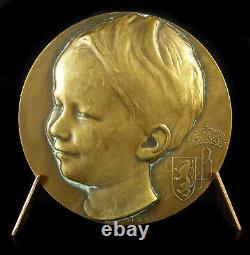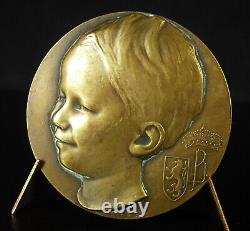Medal Royal Family Belgian Prince/King Baudouin Of Belgium Child Rau




221-shot13 Uniface bronze medal, Belgium. Some traces of manipulation, oxidations on the edge mainly.
Hallmark on the edge (mark on the edge) : no hallmark. The stand is not for sale. Baudouin (in Dutch: Boudewijn; in German: Balduin), born September 7, 1930 at Stuyvenberg Castle and died July 31, 1993 in Motril, is the fifth King of the Belgians. He reigned from July 17, 1951 until his death. Second child and first son of Leopold III and Queen Astrid1, he bore the title of Count of Hainaut while his father was still Duke of Brabant, then became Duke of Brabant on the accession of Leopold III to the Belgian throne.
He is the elder brother and predecessor of King Albert II and the younger brother of Grand Duchess Joséphine-Charlotte of Luxembourg1. His accession to the throne comes at a time of political crisis and his long reign is marked by many others, one of which was the result of the public expression of his Catholic faith.His reign, of more than 42 years, is the second longest of the Belgian monarchy, after that of King Leopold II. Birth and family Prince Baudouin was born on September 7, 1930 at Stuyvenberg Castle, near Laeken, in Brussels, Belgium.
He is the second child and eldest son of Prince Leopold, Duke of Brabant, and his first wife, Astrid of Sweden. Her paternal grandparents are the very popular King Albert I and Queen Elizabeth. Heir to the throne Portrait of Queen Astrid, mother of Baudouin.
In 1934, his grandfather, an avid mountaineer, tragically died in a climbing accident in the Meuse valley. His father then became King of the Belgians, under the name of Leopold III, and Baudouin thus became the heir to the crown. On this occasion, he received the title of Duke of Brabant. The following year, Baudouin's mother died in a car accident. Then, World War II broke out.
It is first experienced in a brief exodus. This begins in La Panne2 and continues in France, at the Château de Montal, then, after the French defeat, in Spain because King Leopold III wanted to remove him, with his brother Albert and his sister Joséphine-Charlotte, from the German invasion of Belgium by evacuating them under the leadership of trusted people, but without Juffrouw (Mademoiselle), the governess to whom Baudouin was particularly attached2.
Baudouin and his younger brother, Albert, in 1940. Repatriated to Brussels, the royal children spent four years there during which the king's second wife, Lilian Baels, made princess of Réthy, took care of them affectionately3 and ensured that they had a life more in keeping with that of the children of the bourgeoisie. Necessary than that which their fathers, grandfathers and great uncles had known. Baudouin, whom she familiarly calls Baud3, studied either at the Château de Laeken or at the Château de Ciergnon. He was educated on the shores of Lake Geneva at the Institut Le Rosey in Rolle (Switzerland)4.
His education during this period was supervised by the Dominican Father Antoine Braun5 who later became his chaplain. Just after the landing, the royal family, which grew with the birth of Alexander of Belgium, was taken by the Nazis to Germany in the fortress of Hirschstein, then to Austria, to Strobl, where it was released on May 7. Then begins the "royal question". Baudouin attended the Collège de Genève (today known as the Collège Calvin); he accompanied his father and stepmother on a long trip to the United States in 19482. King of the Belgians The Royal Question Related article: Royal Question. A bust of the young King Baudouin6.Pending the end of the debates, Prince Charles-Théodore, brother of Leopold III, is appointed Regent of the kingdom until further notice. In 1950, after the popular consultation which gave very different results in Flanders and Wallonia or, more precisely, between the urban and rural electoral districts.
Which corresponds to a delegation of powers. Indeed, a regency and the title of regent were impossible since the law on the end of the impossibility of reigning of King Leopold III had been voted by the Chambers. The prince takes an oath to respect the Constitution and the laws of the Belgian people before the assembled Chambers. It was during this ceremony that the cry Vive la République! Attributed to Julien Lahaut who was assassinated seven days later. Accession to the throne Following the abdication of his father on July 16, 1951, Baudouin, according to the Major Constitution, became the fifth King of the Belgians on July 17, 1951, when the second school war was raging.Beginning of reign For more than 10 years, the young king was under the strong political influence of his father and his stepmother, going so far as to refuse to shake hands with those who, like Hubert Pierlot, had opposed Leopold III during the war7.8. A year after his marriage, Baudouin chose to move away; he will only meet his father and his stepmother on rare occasions, in particular after the death of Queen Elizabeth in 19653.
Black and white photo; the king and queen, wearing a hat and carrying a bouquet of flowers, are particularly smiling. The Queen accompanying the King on a trip to GermanyState funeral The funeral took place on August 7, 1993 in the Cathedral of Saints-Michel-et-Gudule in Brussels during a celeb. This begins in La Panne2 and continues in France, at the Château de Montal, then, after the French defeat, in Spain because King Leopold III wanted to remove him, with his brother Albert and his sister Joséphine-Charlotte, from the German invasion of Belgium by evacuating them under the leadership of trusted people, but without Juffrouw (Mademoiselle), the governess to wh. This item is in the category "Coins & Paper Money\Exonumia\Medals".5" and is located in this country: FR. This item can be shipped worldwide.
